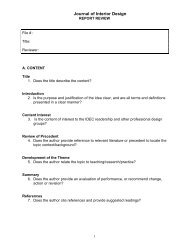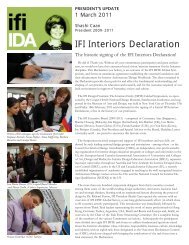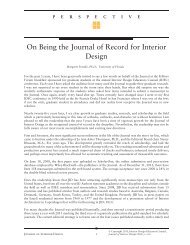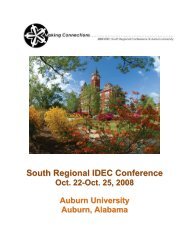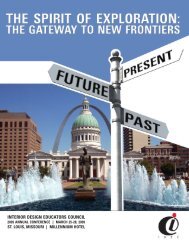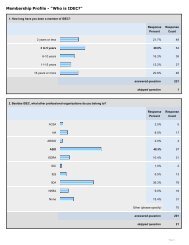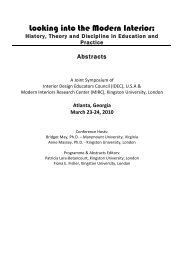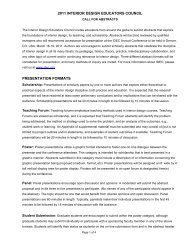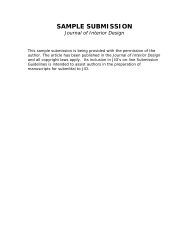A Natural Balance: Interior Design, Humans, and Sustainability
A Natural Balance: Interior Design, Humans, and Sustainability
A Natural Balance: Interior Design, Humans, and Sustainability
Create successful ePaper yourself
Turn your PDF publications into a flip-book with our unique Google optimized e-Paper software.
P E R S P E C T I V EThe living systems ’ecological’ worldview is a different way of thinking about, seeing, <strong>and</strong>engaging with the world than those that have dominated green building eco-efficiencyapproaches to sustainability.The living systems ‘‘ecological’’ worldview is a different way of thinking about, seeing, <strong>and</strong> engaging withthe world than those that have dominated green building eco-efficiency approaches to sustainability (Mang& Reed, 2012). Adopting it will require a higher level of interrelationships between natural, human, <strong>and</strong>built systems, <strong>and</strong> the disciplines within them. Boecher et al. (2009, p xiii) describe the achievement of abroader integration of systems within the sustainability movement as an ‘‘integrative design process (IDP) 8 ’’.IDP is emerging as a natural companion to green building practice because it stimulates collaboration amonga diversity of practitioners with different disciplinary backgrounds <strong>and</strong> viewpoints to make human- <strong>and</strong>natural-systems-based connections <strong>and</strong> interrelationships. The term integration means identifying the variety<strong>and</strong> uniqueness of systems <strong>and</strong> connects them into a whole—including human, biotic, <strong>and</strong> earth systems.Boecher et al. (2009) believe that to achieve the health of the whole, we must ask ourselves how the process ofbuilding can be a catalyst for a discovery path that addresses the interrelationships of all living <strong>and</strong> technicalsystems in the service of sustaining the health of all life (p. xiii).Figure 3 conceptually depicts the trajectory of integrative thinking from technical systems design to livingsystems design (Reed, 2012). As the figure indicates, energy reduction is today’s main target of sustainability.However, this target is not simply a mathematic equation with an x/y coordinate system, but a conceptualdepiction with a human/earth responsibility. Some believe the concept in Figure 3 provides the path to truesustainability. The key in the upper left of Figure 3 shows that the ‘‘Environment,’’ ‘‘Behavioral,’’ <strong>and</strong> ‘‘Social’’bubbles are shown in color symbolizing active engaged status for all three mechanisms impacting humans.Researchers find that the data-driven technical systems of conventional <strong>and</strong> green/high-performance designrequire more energy with less occupant engagement for comfort. In contrast, the pattern-driven living systemsof restorative <strong>and</strong> regenerative design require less energy with more human engagement, underst<strong>and</strong>ing, <strong>and</strong>capacity. Realizing this, some of the leaders in sustainability are using the gift of nature to overtake the‘‘machine as a metaphor’’ thinking for sustainability. This is not to say that technology <strong>and</strong> efficiency are notimportant, but it is the underst<strong>and</strong>ing of the role of technology that is important. The target in Figure 3 isenergy reduction without loss of the human factor. Today’s ‘‘mechanistic’’ view may see buildings as machineswithout feelings. In contrast are the ‘‘ecological’’ interrelationships acquainted with human <strong>and</strong> earth systems.Once we realize that technology is not intended to be used as ‘‘man’s dominion over nature,’’ then we canmove our underst<strong>and</strong>ing of technology toward a fusion of nature <strong>and</strong> human spirit. This philosophy canbecome the driving change. The future trajectory is important, but it is even more important that the interiordesigner as user-advocate be in the center of this ‘‘ecological’’ interrelationship bubble, which is decisive fordeeper engagement of humans <strong>and</strong> what is defined as the deepest level of green as we know it.Stories from Practice: United States Green Building HeadquartersEnergy efficiency or human factors alone are not determinates of project success; rather, it is theinterdependence in which each part affects <strong>and</strong> needs each other. When the United States Green BuildingCouncil (USGBC) needed a new headquarters in 2008, slated as one of the first projects to use the latestversion of LEED® for Commercial <strong>Interior</strong>s, the new requirements dem<strong>and</strong>ed the greatest opportunitiesof interdependence for our multidiscipline team to create something that was more than the sum of itsparts, pushing the limits of each profession. At the same time, we hoped to avoid problems of unintendedconsequences, tradeoffs, <strong>and</strong> a single solution by one profession, which could lead to a bigger problem forthe whole. In our project, we discovered that our ideas, inspirations, <strong>and</strong> innovations connected all our teammembers in ways we did not expect.Journal of <strong>Interior</strong> <strong>Design</strong> xv Volume 37 Number 2 2012





